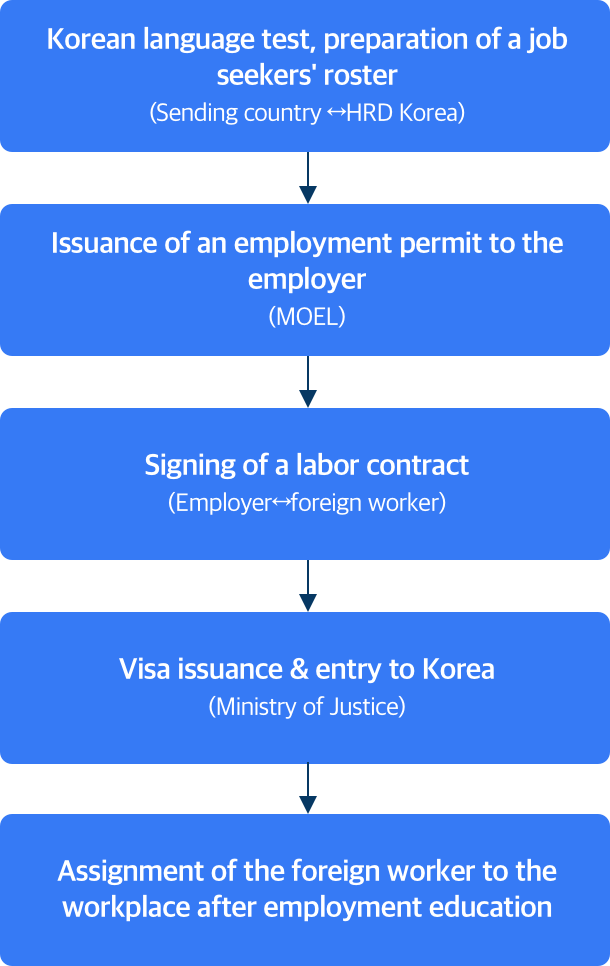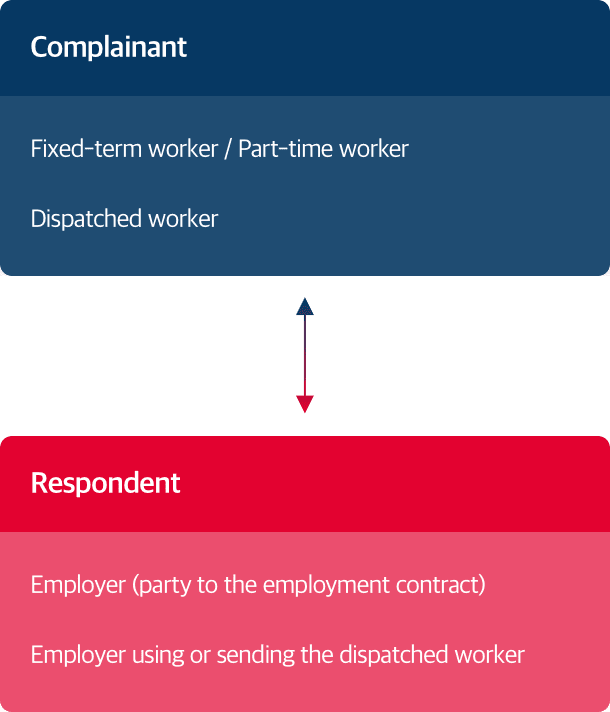Labor Standards
Protecting Working Conditions and Improving Employment Practices
Protecting working conditions
-
The Labor Standards Act in Korea prescribes standards for working conditions, such as wages, working hours, holidays and leave, and thereby provides the legal basis for guaranteeing and improving workers' basic livelihoods. The law stipulates the minimum to be kept, and working conditions must not be degraded below those standards. In principle, the Labor Standards Act applies to all businesses or workplaces ordinarily employing five workers or more. However, some of its provisions (on weekly holiday, recess hours, wages, advance notice of dismissal, retirement benefits, etc.) apply even to businesses or workplaces ordinarily employing four or fewer workers depending on the financial conditions and capabilities to comply with the law.
-
The 2020 minimum wage was set at 8,590 won an hour, a 2.87% rise or 240 won increase from the 2019 minimum wage. A public notice was issued on August 5th, 2020, announcing that the 2021 minimum wage would be set at 8,720 won an hour. The government conducts continuously inspections and provides guidance on labor management to support soft landing of the new minimum wage, and also provided 1.8 trillion won to Job Stability Funds program in 2020, following the implementation of the same program in 2019 (as of August) to relieve the burden for micro-businesses and SMEs. (감독기획과)
-
MOEL is working to sharply increase the number of labor inspectors with law enforcement authority to ensure appropriate working conditions in workplaces and realize a just labor market. The Ministry is also preparing a labor inspection innovation plan to make labor inspection more effective and strengthen its function of preventing problems, such as payment delays.
* Number of labor inspectors: (2017) 1,450 → (2018) 1,902 → (2019) 2,213 → (2020) 2,290
-
To ensure that the basic labor order is in place, intensive inspections were conducted on establishments with records of repeated or habitual delayed payment of wages. As for micro-businesses, inspections centered around guidance and voluntary corrections were conducted (on 5,031 establishments during the first half of the year and 5,022 establishments during the second half) to encourage businesses to comply with the basic labor order.
-
Meanwhile, the government has continued its various efforts to improve people's health and quality of life and increase productivity by reducing working hours. According to the amended Labor Standards Act promulgated on March 20th, 2018, the maximum weekly working hours is down from 68 hours to 52 hours, and even in the case of industries exempted from the new working hour regulations, employers must grant workers a daily rest period of at least 11 hours. In addition to making institutional improvements related to working hours, the government has conducted inspections of major industries and workplaces with long working hours all year round. With the aim of reducing long working hours and thereby creating jobs, the government subsidizes employers who reduce working hours, reform their shift work schemes, provide regular education and training and grant sabbatical leave. It has also helped SMEs voluntarily reduce their working hours by developing and distributing job-sharing manuals and holding information sessions, and strives to create a social consensus and improve public awareness by conducting a nationwide campaign to improve work arrangements and work cultures and certifying companies which have shown outstanding performance in reducing working hours.
-
Moreover, by signing a consignment contract withe th Korea Certified Public Labor Attorneys Association, the government provides support to workplaces with fewer than 20 employees and newly established workplaces, which are less capable of managing their labor affairs, to voluntarily check whether they are in violation of labor laws, make improvements, and get counseling services by seeking help from labor management specialists, such as labor attorneys, before labor inspectors are sent to conduct inspections.
- Support for voluntary improvement of working conditions
-
Labor management specialists provide assistance to micro and small-sized workplaces with poor working conditions to conduct self-checks and improve their work environment, and part of the incurred costs are covered by the government.


- MOEL (budget support)
- Labor management specialists, such as employers' organizations (creation of a task force and assistance to workplaces in establishing and implementing self-assessment and improvement plans)
- Workplaces (implementation of improvement plans)
- MOEL (analysis of results and follow-up management)
Improving employment practices
-
Meanwhile, the Act on the Protection, etc. of Fixed-Term and Part- Time Employees and the Act on the Protection, etc. of Temporary Agency Workers were established and implemented to strengthen protection for non-regular workers (whose number stood at 7.481 million as of August 2019, accounting for 36.4% of all wage workers) on matters including working conditions, etc.
* (Fixed-term employees) Limits period of service to two years, (Part-time employees) Obligates payment of additional wages work performed during hours that exceed the contractual work hours, (Temporary agency workers) Limits the type of work that may be performed by temporary agency workers, and period of service
Accordingly, MOEL conducts inspections and provides guidance for businesses to check the compliance on the lawful management of non-regular workers. Upon identifying illegal use of dispatched temporary agency workers, measures such as issuing of corrective orders for direct employment are taken.
-
In particular, the government operates a discrimination correction system, and provides education‧counseling‧consulting services to resolve discrimination between regular and non-regular workers.
The government also implements a policy that covers part of personnel and labor costs in order to encourage businesses in the private sector to actively convert their non-regular workers into regular status.
-
In addition, the government is seeking to reform the current discrimination correction system, including the expanding the comparison groups for non-regular workers, to double up the efforts to narrow the gap between regular and non-regular workers’ working conditions.
- System of correcting discrimination against non-regular workers
-
Employers are prohibited from giving unfavorable treatment to non-regular workers performing jobs that are same as or similar to those of regular workers in terms of wages, regular bonuses, performance pay and other working conditions and fringe benefits without reasonable grounds.
A non-regular worker subjected to discrimination may file a request for correction of discrimination within six months from the date of occurrence of the discrimination (the end date of the discrimination in cases of continuing discrimination).
Each discrimination case is handled by the Regional Labor Relations Commission or the Regional Employment and Labor Office having jurisdiction over the seat of the workpalce where the discrimination occurred.
Any party dissatisfied with the competent Regional Labor Relations Commission's corrective order or decision to dismiss the case may file an appeal with the National Labor Relations Commission. If the party is still dissatisfied with the results of the appeal, it may bring an administrative lawsuit.
*In cases where a complainant files a request for correction of discrimination with the Regional Employment and Labor Office, if the respondent refuses to comply with a corrective order of its labor inspector, the case is notified to the competent Regional Labor Relations Commission.


-
- Complainant
- Fixed-term worker / Part-time worker
- Dispatched worker
-
- Respondent
- Employer (party to the employment contract)
- Employer using or sending the dispatched worker
interlocking with each other
-
Promoting Labor Welfare
-
Furthermore, the government offers the Employee Assistance Program (EAP), livelihood security loans, credit guarantee support, etc. to promote the welfare of workers. As corporate welfare measures, the government implements the Employee Stock Ownership Plan (ESOP) which allows workers to acquire their company's shares, thereby helping workers build wealth and contributing to labor-management cooperation, and the Employee Welfare Fund System which requires employers to contribute a portion of their company's operating profits to create a fund and use it for employee welfare. In addition, the government operates the Retirement Pension System which requires employers to set aside an amount equivalent to retirement benefits at a financial institution outside the company and pay their employees pensions in the form of an annuity or a lump sum at retirement in order to strengthen employees’ retirement income security.
- Livelihood security loan
-
Livelihood security loans are offered at a low interest rate to workers from low-income vulnerable groups and workers who are experiencing livelihood difficulties due to pay cuts or payment delays, to support their livelihood security.
(Loan requirements) Repayments should be made in equal installments over three years at an annual interest rate of 1.5% after a one-year grace period. In the case of requests for two or more types of loans, the maximum amount of loan should be 20 million won per person. (The maximum loan amount differs according to type of loan.)
* Temporarily eased the loan requirements, etc. due to the spread of COVID-19
- ❶ (Temporarily eased the loan requirements) for three-person households, earning 2/3 of median income or less→for three-person households, earning less than median income (Mar.9.~Dec.31.)
- ❷ (Temporarily raised the maximum loan amount) Living cost to support income reduction (from 10 million won→20 million won), Small amount of living cost (2 million won→5 million won) (May.1.~Dec.31.)
- ❸ (Temporarily raised the limit on the total amount of loan per person) from 20 million won→30 million won (Jul.1.~Dec.31.)
(Types of loans) medical expenses, parent care expenses, funeral expenses, wedding expenses, children's school expenses, living expenses during pay cuts, living expenses during payment delays and living expenses in small amounts
- Employee Stock Ownership Plan
-
The Employee Stock Ownership Plan allows workers to acquire or hold their company's shares with their own money or money contributed by their employer through the employee stock ownership association, thereby helping workers build wealth, creating cooperative labor-management relations and improving corporate productivity.
- Employee Welfare Fund System
-
The Employee Welfare Fund System requires employers to set up a fund using part of their operating profits and manage and operate it efficiently, thereby contributing to workers' livelihood security and welfare, increasing workers' real incomes and boosting the desire to work and a sense of community between labor and management.
- Retirement Pension System
-
The Retirement Pension System is a retirement benefit system introduced in 2005. It requires companies to accumulate necessary funds for retirement benefits at an outside financial institution in advance, so that workers can receive pensions in the form of an annuity or lump sum when they retire. The system (defined-benefit type and defined-contribution type) enables workers to plan for their life after retirement.
-
- Classification
- Form of retirement benefit payment
- Characteristics
- Operator of the pension assets
-
- Retirement pay
- Lump-sum payment
- The employer accumulates the full amount inside the company. → Benefits are vulnerable to bankruptcy.
- Employer
-
- Defined-benefit retirement pension plan
- Annuity or lump-sum payment
- The worker's retirement benefits are pre-determined, and the employer's contributions may change depending on the results of fund management. (outside accumulation of a partial amount)
- Employer
-
- Defined-contribution retirement pension plan
- Annuity or lump-sum payment
- The employer's contributions are pre-determined, and the worker's retirement benefits may change depending on the results of fund management. (outside accumulation of the full amount.)
- Worker
-